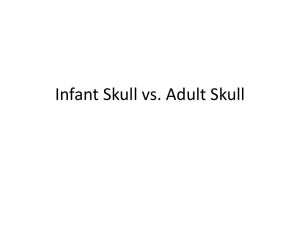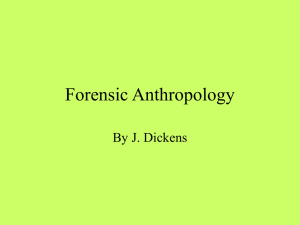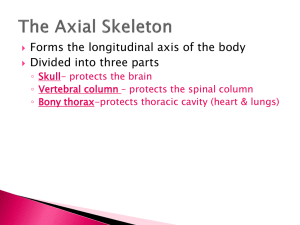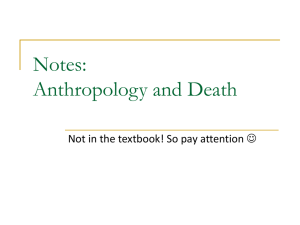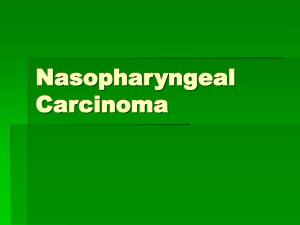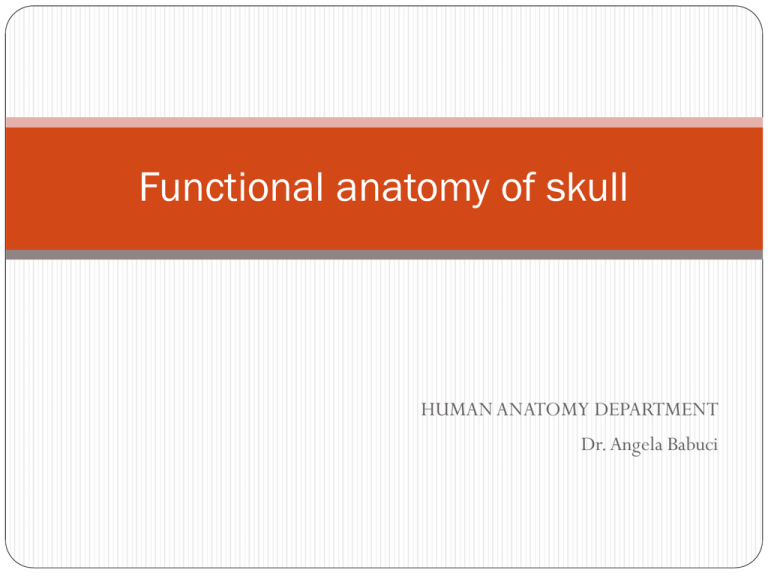
Functional anatomy of skull
HUMAN ANATOMY DEPARTMENT
Dr. Angela Babuci
Plan of the lecture
General data about cranium
Structural peculiarities of the skull.
Development of the skull.
Abnormalities and developmental variants of the skull
Age specific features of the skull
Examination of the skull on alive person
General data
The cranium is the skeleton
of the head. The skull is the
receptacle for the most highly
developed part of the nervous
system, the brain and also for
the sensory organs connected
with it. The initial parts of the
digestive and respiratory
systems are situated in this
part of the skeleton.
The skull
The skull consists of two set of
bones:
The cranial bones that form
the neurocranium, which
lodges the brain.
The facial bones, which form
the viscerocranium. The
bones of the visceral cranium
form the orbits, the oral
cavity and nasal one.
The terms used for the examination of the skull
The frontal norm (norma
frontalis).The shape is also oval, but
the upper part is wider than the
lower one. In frontal norm the
bones of the visceral cranium can
be divided into three floors:
The superior floor of the visceral
cranium corresponds to the
forehead.
The middle floor includes the orbits
and the nasal cavity.
The inferior floor corresponds to
the oral cavity.
The lateral norm
(norma lateralis). The
skull is seen from the
lateral side.
Norma lateralis
exposes to our sight
the temporal,
infratemporal and
pterygopalatine fossae.
The occipital
norm (norma
occipitalis), the
posterior surface of
the skull can be
examined by this
norm.
The basal
norm (norma
basalis),
corresponds to
the external
base of the
skull.
The vertical norm (norma
verticalis). The skull is seen
from the upper part, and it
has an oval shape, but there
are some racial and individual
peculiarities. Examining the
skull in norma verticalis the
following shapes of skull can
be distinguished:
Dolichocephalic
skull – the skull has
an oval shape.
Brachycephalic
skull – it means a
spheroid shape of
the skull.
Mesocephalic skull
– an intermediate
shape between the
previous two forms.
Shapes of the skull
The shape of the skull is oval and the volume is from 1400 to
1600cm³. According to its capacity the following types of the
skull can be distinguished:
Microcephalic cranium, when the brain is smaller than usually, its capacity is
lower than 1300cm³. This type of cranium is characteristic for Australian and some
African tribes.
Mesocephalic cranium, when the brain capacity is from 1300 cm³ to
1450cm³. This type of cranium is characteristic for Africans and Chinese.
Megacephalic cranium, when the brain capacity is more than 1450cm³. Such
a skull is characteristic for European and Japanese.
Hydrocephalic cranium is a very voluminous skull, this type of skull is not
normal, because of pathological condition of the brain.
Topographical areas of the skull
Frontal area
Parietal area
Occipital area
Temporal area
Infratemporal area
Areas of the visceral cranium
Orbital area
Infraorbital area
Nasal area
Area of the lips (region
oralis)
Mental area
Zygomatic area
Cheeks area
Parotideomasseteric area
Structural peculiarities
of the bones of the skull
The bones of the skull
perform predominantly a
protective function. The bones
of the vault of the skull differ
in structure from the other
bones. They consist of spongy
substance which is referred to
as diploe, it means that the
spongy substance is placed
between two plates of
compact bone tissue, the
outer (lamina externa) and the
inner (lamina interna).
Lamina interna is also
called vitreous (lamina
vitrea) because it fractures
more easily than the outer
table in injury to the skull.
Only the temporal squama
has no diploe, among the
membrane bones of the
vault of the skull.
Some bones of the skull are called pneumatic
bones, because they have inside air cavities,
named sinuses
Frontal bone
Sphenoid bone
Ethmoid bone
Maxilla
Development of the Skull
The upper part of the
skull is named the vault
or calvaria and the lower
part forms the base of the
skull.
The bones of the base of the skull develop in cartilage, but the bones of the vault
develop in connective-tissue, and therefore are called the membrane (desmal) or
primary bones.
Development of the skull
The membranous
neurocranium or
desmocranium
develops from
mesenchyme, which
derives from
mesoderm.
Median fontanelles of the skull
Anterior fontanelle
Posterior fontanelle
Lateral fontanelles
Sphenoidal fontanelle
Mastoid fontanelle
In some pathological
conditions can be
present additional
fontanelles:
The naso-frontal
fontanelle.
The medio –frontal
fontanelle is situated in
the middle part of the
frontal bone, when the
metopic suture is very
large.
The sagital fontanelle is
situated along the sagital
suture.
The cerebellar fontanelle
is placed into the
occipital squama on the
posterior border of the
foramen magnum.
Persistence of fontanelles
after
1,5 – 2 years is a signal of
some deviations in the
development of the child
(which usually has a
ricketic nature).
The cartilaginous neurocranium (chondrocranium) is formed
by separate cartilages, which further by encondral
ossification will form the bones of the base of the skull.
The visceral cranium – develops from the first and second
visceral arches.
a) the first or mandibular arch,
b) the second or the hyoid arch.
Development of the skull
The first visceral arch is made up of two parts:
The upper part id called palatoquadratic cartilage;
The lower part is called Meckel's cartilage.
The second visceral arch is also separated into two
parts:
The upper part called – hyo-mandibular cartilage;
The lower one is called – the hyoid cartilage.
The remaining visceral arches beginning with the third are called branchial arches. It means that the
first visceral arch is called the first branchial and so on until the fifth.
In man the bones of the cranium by their
development can be divided into three regions:
The bones which develop from the cerebral capsule
The bones which develop from the nasal capsule
The bones which develop from the visceral arches
The bones which develop from the cerebral capsule.
The primary bones are the
bones of the vault of the skull
(the parietal and frontal, the
occipital squama, the temporal
squama and the tympanic part
of the temporal bone).
These bones are also called
membranous or desmal bones.
The secondary bones are:
the bones of the base of the
skull, the sphenoid bone
excepting the medial plate of
the pterygoid process, the
condylar parts of the occipital
bone and the mastoid process
of the temporal bone.
The bones which develop from
the nasal capsule:
The primary bones are: the
lacrimal bone, the nasal
bone and the vomer.
Development
of the skull
The secondary bones are
encountered as follows: the
ethmoid bone and the inferior
nasal concha.
The bones which develop from the visceral arches
Immobile bones: the upper jaw and
the palatine bone.
The bones which develop from the
visceral arches
Mobile bones: the lower
jaw, the hyoid bone and
auditory ossicles.
The visceral cranium develops from the first, second and
third visceral arches and from the frontal process.
The first visceral arch is divided into two processes:
The maxillary process
The mandibular process
From the maxillary
process develop:
The maxilla, the zygomatic
bone, the palatine bone, the
medial plate of the pterygoid
process of the sphenoid bone.
Development of the bones of the skull
The visceral cranium
develops from the first,
second and third visceral
arches and from the frontal
process.
The first visceral arch is
divided into two
processes:
The maxillary process,
The mandibular process.
The frontal process during its
development is divided into five parts:
unpaired – frontal process
paired – two medial nasal processes and two
lateral nasal processes
From the mandibulary
process develops - the
mandible (through
periosteal ossification).
From the medial
nasal process
develop - the
vomer, the
perpendicular plate
of the ethmoidal
bone.
From the lateral nasal
process develop - the
ethmoidal labyrinths, the
nasal bones and the
lacrimal bones.
From the first visceral
arch develop - the
hammer and anvil (the
ossicles of the middle ear).
From the second visceral
arch develop - the stirrup,
the styloid process of the
temporal bone, and the lesser
horns of the hyoid bone.
From the third
visceral arch
develop - the body
and greater horns of
the hyoid bone.
Developmental Variants and Abnormalities of the
Bones of Skull
The frontal bone
In approximately 10% of
cases the frontal bone
consists of two parts
between which persists the
frontal suture (metopic
suture). The size of the
frontal sinuses varies and in
rare cases they can be
absent.
Abnormalities of the skull
Microcephalia – the skull does not grow because the brain stops its
development.
Cranioschisis – the absence of the vault of the skull.
Macrocephalia – great disproportional dimensions of the skull.
Hidrocephalia – voluminous skull (when there is a lot of cerebrospinal fluid
inside the cerebral ventricles).
Persistence of the craniopharyngeal canal in the Turkish saddle (it contains
remnants of the pharyngeal recess).
Common spinosum and ovale orifices.
Clinoideocarotid foramen (when the anterior clinoid process is connected with
the body of the sphenoid bone).
Assimilation of the atlas by the occipital bone (occipitalization).
Presence of the paramastoid process (when there is additional process in close
relationship with the mastoid one).
Abnormalities of the skull
Plagiocephalia –
premature closure of the
sutures and fontanelles
only from one side.
Abnormalities of the skull
Scaphocephalia –
earlier ossification of the
sagittal suture, being a
condition of appearance
of a long and narrow
skull.
Acrocephalia – closure
of the coronary suture.
Ancephalia – this term isn't correct,
because the absence of the cerebral
extremity of the trunk, does not
permit the development of the embryo
at all.
Meningoencephalocoele
Craniostenosis – premature
ossification of the fontanelles and of
the sutures.
Abnormalities of the occipital bone
The superior part of the occipital squama can be totally or
partially separated from the rest of the bone by a transverse
fissure. As a consequence develops an additional bone named the
intraparietal bone (os intraparietale).
Abnormalities of the occipital bone
Around the occipital bone
sometimes can appear accessory
bones of the cranium (ossa
suturalia). In rare cases the
external occipital protuberance
can rich very big dimensions. In
can be present the third occipital
condyle, which is situated on the
anterior border of the greater
occipital orifice. In case it is
present, then it articulates with
the anterior arch of the first
cervical vertebra forming an
additional joint.
Abnormalities of the bones of the skull
The ethmoidal bone
The ethmoidal cells can be
various in shape and size.
Often can be present the
supreme nasal concha.
The parietal bone
When the ossification
nuclei do not fuse the
parietal bone consists of
two parts, one superior and
another inferior.
Abnormalities of the temporal bone
The temporal bone
The jugular notch of the
temporal bone can be separated
by an intrajugular process into
two parts and if the same process
does exist at the jugular notch of
the occipital bone than the
jugular orifice is double. The
styloid process can be absent or
vice-versa in case of ossification
of the stylohyoid ligament it can
be very long.
Variants of the bones of the viscerocranium
The lacrimal bone
The shape and dimensions of this bone are not constant, and in case of its absence it is substituted
by the excessive growth of the frontal process of the maxilla or by the orbital plate of the ethmoid
bone.
The maxilla
The dental sockets may frequently very in number and shape. Sometimes can be present impair
incisive bone which is characteristic for mammals. The incisive canal and the maxillary sinus may
very in shape and size. The most redoubtable developmental abnormality of the maxilla is the fissure
of the hard palate (palatum fissum).
The inferior nasal concha
This bone frequently varies in shape and size, but especially varies its processes.
The vomer
The vomer can be curved to the right or to left side.
The mandible
The right and left sites of its body often are asymmetrically. The mandibular and mental orifices can
be double, and also the mandibular canal may be double.
The hyoid bone
Dimensions of the body, of the greater and lesser horns of the hyoid bone are not constant.
Periods of the Growth of the Skull
The first period (the first 7 years) is characterized by intensive
growth, mainly of the posterior part of the skull.
The second period (from the age of 7 to the beginning of
puberty), and this is the period of relative rest.
The third period, from the beginning of puberty (13-16 years
of age) to the end of skeletal growth (20-23 years of age), is
again one of intensive growth, and during this period growth
mainly the anterior part of the skull.
The age changes that take place later in the human skull are
characterized by the following peculiarities:
I. Fusion of the separate parts of bones forming a single bone:
Both halves of the mandible fuse at 1-2 years of age.
Fusion of both halves of the frontal bone at the site of the frontal suture
occurs from 2 years until 7 years of age.
Fusion of all parts of the occipital bone between ages 3 and 5.
Synostosis between the body of the occipital bone and the sphenoid bone
to form a single os basilare at the level of sphenooccipital synchondrosis
occurs between the ages of 18-20, and with the development of this
synostosis growth of the base of the skull in length ceases.
II. Disappearance of the fontanelles and the formation of
sutures with typical serrated contours at 2-3 years of
age.
III. Appearance and future development of
pneumatization.
The maxillary sinus begins to develop in the 5-6th month of the
intrauterine life and is demonstrated on radiograph of the skull at
birth as an elongated clear space the size of a pea. It reaches full
development in the period of replacement of deciduous teeth by
the permanent teeth and is distinguished by great variability.
Age peculiarities of the skull
The air sinuses are still not developed in the skull of a new born.
The crests, muscular tuberosities, and lines are not pronounced
because the muscles do not function yet and are therefore weakly
developed. Weakness of the muscles of mastication due to the
absence of the masticating function causes weak development of
the jaws: the alveolar processes are hardly formed and the
mandible consists of two non-united halves. As a result the visceral
cranium is less prominent in relation to the cerebral skull and is
only 1:8 the size of the cerebral, whereas in adult their ratio is
1:4.
Age specific features of the skull
The skeleton of the skull in
its development depends on
the development of the
brain, sense organs, oral
and nasal cavities. The
neurocranuim lodges the
brain and the
viscerocranuim with the
participation of some bones
of the neurocranium forms
cavities for the sense
organs.
Sex Specific Features of the Skull
The skull of a man is larger than the skull of a woman in average. The capacity of
the skull in man also is greater than in female by approximately 10%. This fact is
determined by the sex difference in the body dimensions. The fact that the
muscles in female are not as well developed as in man assures to the skull a
smooth surface, but in man the roughnesses at the sites of muscle attachment is
more pronounced. In female the superciliary arches are less prominent, the
forehead is more vertical, and the vertex flatter. All these signs sometimes are
not well distinct and cannot serve as reference points in determining the sex of
an individual. In approximately 20% of cases the capacity of the female skull is
no less than the average capacity of the male skull. The smaller size of the female
skull does not signify poorer development of the brain of female but
corresponds to the smaller dimensions and proportions of the female body.
Nuclei of Ossification
The frontal bone begins to
form during the 9th week of the
intrauterine development on the
basis of connective tissue by
endesmal osteogenesis. Two
nuclei of ossification appear in
this bone at the level of the two
frontal tubers. In newborn this
bone consists of two symmetrical
parts which are united by
metopic suture.
Nuclei of Ossification
Nuclei of ossification in the sphenoid
bone appear beginning with the 9th
week of the intrauterine development.
There form five pairs of nuclei of
ossification. The biggest part of this
bone develops on the basis of cartilage,
but the lateral portion of the greater
wings and the medial plate of the
pterygoid process (with the exception
of the hamulus pterygoideus) are
membranous in their origin.
Nuclei of Ossification
It is a secondary bone by its
development. Four ossification nuclei
appear in this bone in each of its parts.
The superior part of the occipital
squama is membranous in its origin
and here two nuclei are formed. The
ossification nuclei begin to form in
the 8 and 10th weeks of intrauterine
development, but all parts of the
occipital bone fuse to form a single
bone at 3-5 years of age.
Nuclei of Ossification
The parietal bone bone
develops on the basis of
connective tissue and a single
nucleus of ossification appears
during the 8th week of
intrauterine development in
parietal tuber.
Nuclei of Ossification
The ethmoid bone has three nuclei of
ossification: one median and two lateral.
The temporal bone
The nuclei of ossification in the temporal
bone appear in the auditory capsule cartilage
during the 5-6th weeks of intrauterine
development. The temporal squama (9
week) and the tympanic (10 week) parts of
this bone develop on the basis of connective
tissue. The styliod process develops from the
cartilage of the second visceral arch, and it
has two nuclei of ossification (one before
birth and another at 2 years of age). Fusion
of the parts of the temporal bone, begin
after birth and continue until 13 years of
age. The styloid process unites with temporal
bone beginning with 2 years and lasted until
12 years of age.
Nuclei of Ossification
The maxilla
At the end of the second month of the
intrauterine life few nuclei of
ossification appear in its connective
tissue.
The small bones of the visceral cranium such
as: the palatine, nasal, lacrimal,
zygomatic bones and the vomer develop
from 1, 2, or even 3 nuclei of
ossification. These nuclei appear at the
end of the second and the beginning of
the third month of the intrauterine
development. The inferior nasal concha,
as it was mentioned above, develop as
well as the ethmoid bone from the nasal
capsule cartilage.
Nuclei of Ossification
The lower jaw develops from connective
tissue of the Meckel's cartilage. In both
halves of the mandible appear by one
nucleus in the 2nd month of the
intrauterine development. Fusion of
both parts of the mandible occurs at 1-2
years of age.
The hyoid bone
Nuclei of ossification appear in its
greater horns, at about 8-10th month of
the intrauterine development, in its
lesser horns during the 1st and 2nd years
of age. Fusion of its parts occurs at 2530 years of age.
Examination of the Skull on Alive Person
The bones of the skull can be examined by X-rays methods, by
somatoscopy and palpation. The supraorbital borders of the frontal
bones, the frontal and parietal tubers, can be seen by a simple
inspection. The glabela, the supraorbital notch, the metopic
suture, the superior temporal line, the external occipital
protuberance, the supreciliary arch, the superior nuchal lines, the
can be examined by palpation.
On the sphenoid bone can be palpated the temporal surface of the
greater wings. By rhinoscopy can be examined the perpendicular
plate of the ethmoid bone and the nasal concha.
Examination of the Skull on Alive Person
In children until 1 - 2 years of age the great fontanelle can be
palpated and the small one can be palpated until 2 – 3
months.
The bones of the viscerocranium also can be examined by
somatoscopic method and by palpation. On the temporal
bone can be palpated its squama, the mastoid process, the
spina suprameatum, which is used as an reference point in
trepanation of the mastoid antrum, and initial portion of the
external auditory meatus (the other part of the external
auditory meatus can be examined by otoscopy).
Examination of the Skull on Alive Person
At the level of the viscerocranium can be seen the cheek
bones, caused by the zygomatic bones, the zygomatic arch,
the head of the mandible, the mandibular angle, and the
inferior margin of the body of the mandible.
By palpation also can be examined the nasal bones, the
margins of the piriform aperture, the anterior nasal spine,
the mental protuberance, the inferior margin of the
mandible, the posterior margin of the mandibular branch, the
angle of the mandible, and all the mentioned above
formations.
Examination of the Skull on Alive Person
The mandibular head can be palpated by a finger, which is
introduced into the external acoustic meatus. Through the
vestibulum of the mouth and the oral cavity proper can be
palpated the alveolar arches and juga alveolaria, the hard
palate, the inferior margin of the mandible, the canine fosa.
In stomatological practice the infraorbital and mental orifices
are used for the trigeminal anaesthesia.
Examination of the Skull on Alive Person
An efficient method of examination of the skull shape, of its
dimensions and modifications of its configuration in
anthropology and medicine is the craniomentry, or
establishment of the dimensions and diameters of the skull.
For this aim are used reference points, named craniometrical
points. Craniomentrical points are divided into median
(impair) and lateral (pair) points.
Median craniometrical points
Gnation – the lowest point from of the chin.
The mental (symphysian) point – the most
prominent point of the mental eminence.
The inferior incisive point (infradental) –
situated on the alveolar arch, between the
median incisors.
The superior incisive point (prostion) –
which is situated on the alveolar process of
the maxilla between medial incisors.
Nasospinal point (spinal) – located on the
anterior nasal spine.
Rhinion – the inferior point of the suture
between the both nasal bones.
Nasion – the point of intersection of the
fronto-nasal suture with the median line.
Median craniometrical points
Glabela – corresponds to the median
area, which is situated between the
superciliary arches.
Ofrion – the point of intersection of
the frontal minimal diameter with
the median line; (the frontal minimal
diameter is the list distance between
the both temporal crests of the
frontal bone).
Bregma – the point of intersection
of the coronarian suture with the
sagital one, and it corresponds to the
vertex of the vault, or to the highest
point of the skull.
Median craniometrical points
Obelion – is the point in which the sagital
suture is intersected by the line which
unites to each other both parietal orifices.
Lambda – the point which unite the
sagital suture with the lambdoid one.
Opistocranion – the most posterior
point of the sagittal plane of the skull.
Innion – the point which corresponds to
the external occipital protuberance.
Opistion – the median point of the
posterior border of the foramen
magnum.
Basion – the median point of the anterior
border of the foramen magnum.
Lateral craniometrical points
The maxillofrontal point – is situated
at the level of the suture between the
frontal process of the maxilla and the
frontal bone.
Dacrion – is the point where the
lacrimofacial and lacrimofrontal
sutures meet each other.
The malar point – is the most
prominent point of the zygomatic
bone.
Pterion – is the point where the
squama of the temporal bone, the
parietal bone and the greater wing of
the sphenoid bone and the frontal
bone meet each other.
Lateral craniometrical points
The coronarian point – is the most
lateral point of the coronarian suture.
Stefanion – is the point where the
coronary suture meets the superior
temporal line.
Gonion – corresponds to the angle of
the mandible.
The auricular point – is situated in the
middle of the external auditory
meatus.
Eurion – is the highest point of the
parietal eminence.
Asterion – is the point where the
temporal bone, the parietal one and
the occipital bone meet each other.
Diameters of the skull
The transversal diameter – is the distance in centimeters between the
most far-off points of the both parietal bones (or between the two
eurions).
The anteroposterior diameter – is the distance in centimeters between
the glabela and the opistocranion.
The auricular height – is the distance in centimeters between the vertex
and the superior margin of the external auditory meatus on the vertical
line that intersects perpendicularly the Frankfurt's horizontal line.
Frankfurt's horizontal line is the line which passes through the most
inferior point of the infraorbital margin and through the superior
margin of the external auditory meatus.
Indexes of the skull
The longitudinal cephalic index can be determined
as follows:
The transversal diameter (in cm) x 100 reported to the
anteroposterior diameter (in cm).
If the obtained value is 75 or less it is characteristic for the
dolichocephalic skull or short skull.
When the value is from 76 to 79 the skull is considered to be
mesocephalic skull.
The value of 80 and more is characteristic for the
brachycepahalic skull or long skull.
The vertical cranial index can be
determined by the following account
The auricular height of the head (in cm) x 100 reported to
the anteroposterior diameter (in cm).
If the obtained value is 75 and more it denotes a hipsicephalic
skull.
When the value is from 70 to75 the skull is of a middle
height, or ortocephalic skull.
If the value is lower than 70 it characterizes the plate skull, or
platicephalic skull.
The facial index is determined by the
following account:
Ofrioalveolar line (in cm) x 100 reported to the bizygomatical diameter, (the
ofrioalveolar line is the distance between the ofrion and mental points).
The facial index has a value from 62 to 74. An index with a value more than this
indicates an elongated face, and an index with a value less than this indicates a wide face.
Position of the facial cranium reported to the cerebral one may be characterized by
facial angle. The facial angle represents the profile line (traced between the nasion and
prostion) and the horizontal line (traced through the inferior point of the profile line)
measured in degrees.
The facial angle lesser than 80˚ characterizes prognatias or
prognatismus.
A right facial angle is registered in ortognatismus.
The most common values for the facial angle are values from 80˚
to 90˚, and are characteristic for mesognatismus or nasognatismus.
Two forms of prognatismus can be distinguished:
1. Total prognatismus, when there is a protrusion both of the maxilla
and of the mandible.
2. Inferior prognatismus, when only the mandible protrudes
anteriorly.

